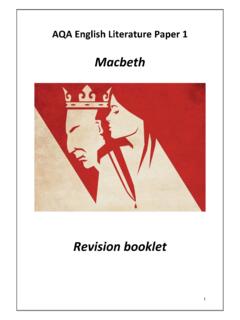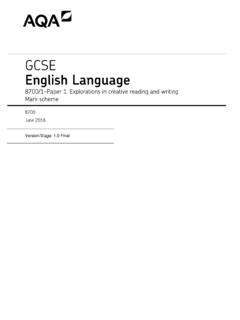Transcription of AQA Power Conflict Revision Booklet - Bishop Fox's School
1 poetry . Mr S Cox Power AND. Conflict . ABOUT: This Booklet is designed to support you through the study of poetry for your English Lessons. The work in this Booklet can be used in a number of ways: a regular homework, Revision aid, class resource or even just a catch up material if you have missed a topic. One thing this Booklet is not however, is a quick fix. The exercises and information in this Booklet are not made so you can just skip through or answer a few questions and then move on. If you do not read the instructions you will find that the work is not always correct and if you do not take the time to answer carefully in full sentences you will probably find that you don't practise your ability to answer questions as effectively as you would like. The keys to success in English are: 1-Read lots, it honestly helps (there are studies into this and everything).
2 2-Start early, if you leave it all to the end you wont give it time to settle in your mind, the things you are probably best at are those you practise every day for years, English is the same. 3-Work hard, it is no use just being smart because if you expect to coast through on your intelligence you may be disappointed, and if not in your GCSE's then your A levels or Degree, trust me when I say it comes back to haunt you! Best of luck! By the way, y o pages you wo u may see this logo and co rk come with ea through. This is your qu lourful boxes on many of th ch topic, you estions or thin e these properl sh kin y and label y ould make sure you take g points that book or on p our work app the time to d a ro o topic title, pa per then you should alway priately. If you work in a ge number a s m a ke sure there nd que is where you are stion number so it is easy to a clear working from know.
3 The works included in this Booklet have been heavily influenced by the work of other teachers and academics. The textual samples are from the Power and Conflict Cluster from the AQA Anthology and the creator of this Booklet claims no credit for any of the textual extracts. CONTENTS: 1 KEY TERMS. 2 OZYMANDIUS. 3 LONDON. 4 PRELUDE (EXTRACT). 5 MY LAST DUCHESS. 6 CHARGE OF THE LIGHT BRIGADE. 7 EXPOSURE. 8 STORM ON THE ISLAND. 9 BAYONET CHARGE. 10 REMAINS. 11 POPPIES. 12 WAR PHOTOGRAPHER. 13 TISSUE. 14 THE EMIGREE. 15 CHECKING OUT ME HISTORY. 16 KAMIKAZE. 17 THEMES, STRUCTURE AND Revision . TEACHING AND LEARNING. f this There is more than one way to skin a cat, this Booklet can be m a k e t he most o w to d a stu- AKA: Ho s a t eacher an used to fit whatever you want, you can teach from or simply s s a Booklet in cla ideas and make it an online Revision or cover tool, whatever, here are some ge n e r al teaching e dent, som y o u could fo llow.
4 Ideas of how you can incorporate it into your lesson. t u re s struc LOOKING AT THE POEMS: Depending on the size of the poem and the lesson it would make sense that they can take more than one lesson to explore. A good way to structure the work over those lessons are: STARTERS: Initially mind maps or key images to explore what students already understand of context to do with the poem, another helpful tool is to look at certain lines in isolation (either as a group or in pairs) to see what students think this shows about the poem. Later lessons can involve quick recaps and pop quizzes to remind students of key quotes, themes or technical features DEVELOPMENT: It is advised before showing or relying too heavily on the information in the book to get students to begin by looking at the poem and annotating themselves. Additional annotations can be worked through in groups or a class with direction, weaker groups could be given key terms to look for or lines to explore and thus guide their learning.
5 It is then recommended (ideally on the next page in their book/folder) to summarise context, themes and structure (as we do in the Booklet ), to allow students to access Revision notes in their own words. REINFORCE: Call it a plenary if you will but to show something has sunk in I would recommend they evaluate/. summarise the poem producing PEE paragraphs to support their findings. This could be through a given direction or simply asking explore 3 ways this poem shows Power / Conflict . LOOKING AT THEMES/STRUCTURE. Towards the back of the Booklet , poems are linked by theme of structural styles to help students build on their understanding as well as compare and contrast, STARTERS: Initially they could be given give words/themes and be asked to pick the 3 poems they would link here and why, weaker groups could simply give 1-2. Recapping poems is also useful and students can try and talk for 30-60 seconds on a poem, whoever can get closest without repeating ideas wins.
6 DEVELOPMENT: It is advised to summarise how the poems (those given or which you decide) fit the themes, It would be useful to find 3/4 quotes for each poem based around those themes, this will allow students to quickly revise key poems and ideas. REINFORCE: Each theme/structural element has a sample task where students are advised to treat it like an exam. They should do a standard 4-6 paragraph essay with introduction and conclusion. At this point it is also useful to look at the exam mark scheme and really apply students knowledge to what they are being asked to perform. SUGGESTION: Although Power points can be useful we have steered away here. Any of these resources of information can be copied over to a slide, but try and avoid repeating information for the sake of it, if they are watching a slide they are not watching you. It may be useful to include key video and images for help with context or readings but these are all additional elements which will fit your own teaching/learning style.
7 ASSESSMENT OBJECTIVES. If you are using AQA, your work will be assessed on these objectives, that means you should always aim to haave work which shows them off. They all get marks but not all the same amount, so AO1 and AO2 will get you in the region of 80% of your poetry marks. AO1: Read, understand and respond to texts. Students should be able to: maintain a critical style and develop an informed personal response use textual references, including quotations, to support and illustrate interpretations. AO2: Analyse the language, form and structure used by a writer to create meanings and effects, using relevant subject terminology where appropriate. AO3: Show understanding of the relationships between texts and the contexts in which they were written. AO4: Use a range of vocabulary and sentence structures for clarity, purpose and effect, with accurate spelling and punctuation MARK SCHEME.
8 A Sample of the mark scheme from AQA on the poetry question highlights the following. Level 6 (Top Level). At the top of the level, a candidate's response is likely to be a critical, exploratory, well-structured comparison. It takes a conceptualised ap- proach to the full task supported by a range of judicious references. There will be a fine-grained and insightful analysis of language and form and structure supported by judicious use of subject terminology. Convincing exploration of one or more ideas/perspectives/contextual fac- tors/interpretations. The levels contain similar criteria but the standard differs as they decrease. Level 6 : Convincing, critical analysis and exploration THAT MEANS THE EXAMINER WILL EXPECT YOU TO: Level 5 : Thoughtful, developed consideration Compare and contrast in every paragraph Level 4 : Clear understanding Give relevant examples/quotes Level 3 : Explained, Structured comments Don't just explain what happens, explain why Level 2 : Supported, relevant comments Give more than 1 idea about possible meanings Level 1 : Simple Explicit commentd Use accurate language to discuss devices/structure In order for work to be level 5/6 it needs to be convincing and thoughtful, that means you need to LEARN and UNDERSTAND the poems and what they are about, anything less than a solid understanding will not help, and if you don't revisit the poems regularly your work is more likely to sound uncertain or confused.
9 Remember, English is about style as well as substance. GLOSSARY OF DEVICES. SOUNDS. Alliteration Words beginning with same letter sounds to create a notably emphasis on words dark dreary dreams . Assonance Like alliteration, the sounds of assonance come from within the word rather than the start Fearful tears of misery (emphasis on the e-a-s sounds). Consonance Consonant sounds at the end of words wet set of regrets . Cacophony Harsh sounds in order to make a discordant sound. dark knuckles wrapping across bricks (often Ks, Ts, Cks). Onomatopoeia Words which sound like the effect they describe splash, slap, crack . Repetition Repeating words over a verse, stanza or poem to draw focus and add emphasis. Rhyme Words with similar ending sounds creating a music like effect or flow theme/stream/dream . Rhythm Organisation of words to create a noticeable sound or pace, not necessarily musical but with a clear beat'.
10 Can include the structure of the work and is often measured in syllables. Pattern Name Example / Iamb/Iambic invite / Trochee/Trochaic deadline / Anapest/Anapestic to the beach / Dactyl/Dactylic frequently / / Spondee/Spondaic true blue There are five basic rhythms and the amount of them [known as feet], can make different meters (pentameter is 5. of the pattern monometer would be just 1, triameter 3 etc). MEANINGS AND LINGUISTIC DEVICES. Allegory Something symbolic, an allegory can often be a story that represents larger things, like the tortoise and the hare. Allusion- Referring to something well known, nowadays that could be a celebrity but it could be anything that fits the context of the poem (Shakespeare will make very old allusions we may not understand). Ambiguity/Ambiguous A word or idea meaning more than one thing to provoke thought.


